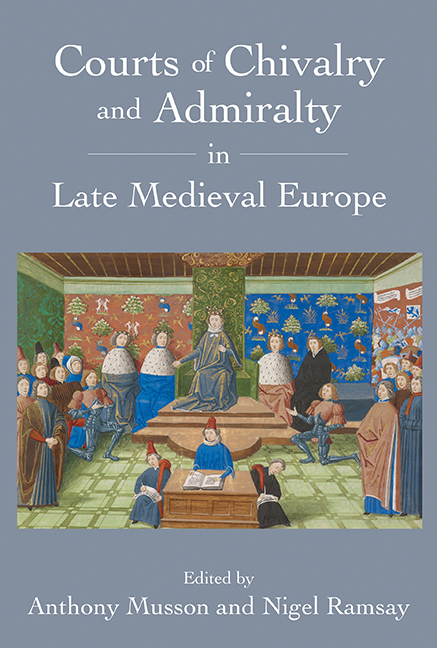Book contents
- Frontmatter
- Contents
- List of Illustrations
- Notes on Contributors
- Preface
- A Note on Editorial Practice
- List of Abbreviations
- Introduction
- Chapter 1 Heralds and the Court of Chivalry: From Collective Memory to Formal Institutions
- Chapter 2 French Armorial Disputes and Controls
- Chapter 3 Art, Objects and Ideas in the Records of the Medieval Court of Chivalry
- Chapter 4 Sir Robert Grosvenor and the Scrope–Grosvenor Controversy
- Chapter 5 From Brittany to the Black Sea: Nicholas Sabraham and English Military Experience in the Fourteenth Century
- Chapter 6 ‘Armed and redy to come to the felde’: Arming for the Judicial Duel in Fifteenth-Century England
- Chapter 7 The Jurisdiction of the Constable and Marshals of France in the Later Middle Ages
- Chapter 8 The Origins and Jurisdiction of the English Court of Admiralty in the Fourteenth Century
- Chapter 9 The Consulate of the Sea and its Fortunes in Late Medieval Mediterranean Countries
- Chapter 10 The Admiralty and Constableship of England in the Later Fifteenth Century: The Operation and Development of these Offices, 1462–85, under Richard, Duke of Gloucester and King of England
- Chapter 11 Some Dubious Beliefs about Medieval Prize Law
- index
Chapter 4 - Sir Robert Grosvenor and the Scrope–Grosvenor Controversy
Published online by Cambridge University Press: 28 June 2018
- Frontmatter
- Contents
- List of Illustrations
- Notes on Contributors
- Preface
- A Note on Editorial Practice
- List of Abbreviations
- Introduction
- Chapter 1 Heralds and the Court of Chivalry: From Collective Memory to Formal Institutions
- Chapter 2 French Armorial Disputes and Controls
- Chapter 3 Art, Objects and Ideas in the Records of the Medieval Court of Chivalry
- Chapter 4 Sir Robert Grosvenor and the Scrope–Grosvenor Controversy
- Chapter 5 From Brittany to the Black Sea: Nicholas Sabraham and English Military Experience in the Fourteenth Century
- Chapter 6 ‘Armed and redy to come to the felde’: Arming for the Judicial Duel in Fifteenth-Century England
- Chapter 7 The Jurisdiction of the Constable and Marshals of France in the Later Middle Ages
- Chapter 8 The Origins and Jurisdiction of the English Court of Admiralty in the Fourteenth Century
- Chapter 9 The Consulate of the Sea and its Fortunes in Late Medieval Mediterranean Countries
- Chapter 10 The Admiralty and Constableship of England in the Later Fifteenth Century: The Operation and Development of these Offices, 1462–85, under Richard, Duke of Gloucester and King of England
- Chapter 11 Some Dubious Beliefs about Medieval Prize Law
- index
Summary
The Grosvenors of Hulme
Perhaps, like any sensitive parent, Robert Grosvenor had hung on to life until the Christmas season was over. Two days after Epiphany, on 8 January 1465 he made his will. He died on the following day leaving six daughters as his heirs, the estate ultimately divided amongst them, though not explicitly mentioned in the will. Grosvenor's career was by this time lengthy and respectable. He had sat on final concord panels as an esquire, been a collector for the Cheshire tax, the mise, in Northwich hundred, and in 1433 had been granted custody of the lands of Sir Hugh Calveley, son of the great Cheshire soldier; in 1441 he was amongst a select group of Cheshire gentry retained by Humphrey, duke of Buckingham, as men who could broker the duke's influence in the county. Grosvenor's rank and standing in East Cheshire were thus well-established and, as a man in his late fifties, he ought perhaps to have paid more attention to that all too common but always unwelcome prospect for the late-medieval gentry, failure in the male line. The evidence is, however, somewhat equivocal. Aware of the demise of his name and memory at Hulme, and, reacting like many gentry facing similar problems, he had been investing heavily in the building of a new family chapel at nearby Nether Peover. His testament asked for burial in the cemetery there, but its terms were later expanded to include an endowment for a perpetual chaplain to sing for the souls of himself and his wife, Joan, and his heirs in the chapel newly ‘being built’. The church of St Oswald at Nether Peover is one of the county's surviving timber-framed churches, the body of the church and its aisles all originally under a single timber roof. Grosvenor's chapel was probably the aisle to the south side of the chancel; but the scale of the new building work is not clear from this document, however. Presumably he anticipated that his tomb would be translated there at completion.
- Type
- Chapter
- Information
- Courts of Chivalry and Admiralty in Late Medieval Europe , pp. 75 - 94Publisher: Boydell & BrewerPrint publication year: 2018
- 1
- Cited by

